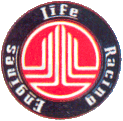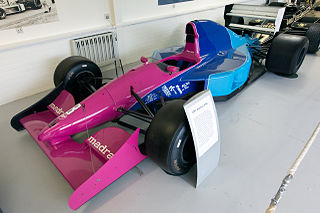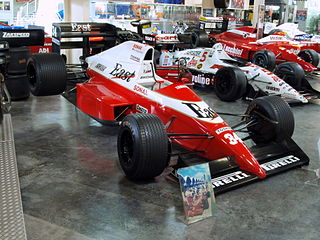Motor Racing Developments Ltd., commonly known as Brabham, was a British racing car manufacturer and Formula One racing team. It was founded in 1960 by the Australian driver Jack Brabham and the British-Australian designer Ron Tauranac. The team had a successful thirty-year history, winning four FIA Formula One Drivers' and two Constructors' World Championships, starting with two successive wins in 1966 and 1967. Jack Brabham's 1966 Drivers' Championship remains the only such achievement using a car bearing the driver's own name.

The Formula 3000 International Championship was a motor racing series created by the Fédération Internationale de l'Automobile (FIA) in 1985 to become the final preparatory step for drivers hoping to enter Formula One. Formula Two had become too expensive, and was dominated by works-run cars with factory engines; the hope was that Formula 3000 would offer quicker, cheaper, more open racing. The series began as an open specification, then tyres were standardized from 1986 onwards, followed by engines and chassis in 1996. The series ran annually until 2004, and was replaced in 2005 by the GP2 Series.

The 1989 Brazilian Grand Prix was a Formula One motor race held at Jacarepaguá, Rio de Janeiro on 26 March 1989. It was the first race of the 1989 Formula One World Championship.

The 1990 United States Grand Prix was the opening motor race of the 1990 Formula One World Championship held on March 11, 1990, in Phoenix, Arizona. It was the 32nd United States Grand Prix since the American Grand Prize was first held in 1908, and the 25th under Formula One regulations since the first United States Grand Prix was held at Sebring, Florida in 1959. It was the second to be held on the streets of Phoenix and ran over 72 laps of the 4 km-circuit.

The 1989 FIA Formula One World Championship was the 43rd season of FIA Formula One motor racing. It began on 26 March and ended on 5 November. Alain Prost won his third Drivers' Championship, and McLaren won the Constructors' Championship.
Stefano Modena is an Italian former racing driver, who competed in Formula One from 1987 to 1992.

EuroBrun Racing was a Swiss-Italian Formula One constructor based in Senago, Milan, Italy. They participated in 46 Grands Prix between 1988 and 1990, with an Italian license, entering a total of 76 cars.

Life was a Formula One constructor from Modena, Italy. The company was named for its founder, Ernesto Vita. Life first emerged on the Formula One scene in 1990, trying to market their unconventional W12 3.5-litre engine.

Judd is a brand of racing car engines built by Engine Developments Ltd., a company founded in 1971 by John Judd and Jack Brabham in Rugby, Warwickshire, England. Engine Developments was intended to build engines for Brabham's racing efforts, and became one of the first firms authorised by Cosworth to maintain and rebuild its DFV engines, but has since expanded into various areas of motorsport.

The Lotus 101 was the car with which the Lotus team competed in the 1989 Formula One World Championship. It was powered by a Judd V8 engine and driven by triple World Champion Nelson Piquet and Satoru Nakajima, in their second and third seasons with the team respectively.

The Williams FW12 was a Formula One racing car used by the Williams team for the 1988 season. An updated version, the FW12C, was used for 12 of the 16 races of the 1989 season. The FW12 was Williams's first naturally aspirated car since the FW08 and FW08C used in the 1982 and 1983 season.

The Tyrrell 020 was a Formula One racing car designed by Harvey Postlethwaite and George Ryton for Tyrrell Racing and raced during the 1991 season, the entire 1992 season and the half of 1993 season.

The Brabham BT58 was a Formula One racing car designed by John Baldwin and Sergio Rinland for the Brabham team which raced in the 1989 season. The teams cars were driven by Italian Stefano Modena and the 1988 World Sportscar Champion, the returning Martin Brundle. It made its debut at the 1989 Brazilian Grand Prix and continued until the first two races of 1990. The best result achieved was a third place at the 1989 Monaco Grand Prix driven by Modena. The car was powered by the Judd V8 engine and ran on Pirelli tyres.

The Brabham BT60 was the final series of Formula One racing cars built for the Brabham Formula One motor racing team. Designed by Sergio Rinland, they raced in the 1991 and 1992 Formula One World Championships. The car brought to a close Brabham's 30 years of construction of purpose-built racing cars, which began with Jack Brabham and Ron Tauranac and the Brabham BT1 Formula Junior design in 1961.

The Benetton B191 is a Formula One racing car, with which the Benetton team competed in the 1991 Formula One season and at the beginning of 1992. Designed by John Barnard and Mike Coughlan, the car made its debut at the 1991 San Marino Grand Prix, driven by two Brazilian drivers, three-time World Drivers' Champion Nelson Piquet and Roberto Moreno. The B191 was powered by the Ford HBA5 V8 engine in an exclusive deal with Ford, and ran on Pirelli tyres. Following the Belgian Grand Prix the team replaced Moreno with German newcomer Michael Schumacher.

The Zakspeed 891 was a Formula One car for the 1989 season run by the German Zakspeed team. Its drivers were German Bernd Schneider in his second year with the team and F1 rookie Aguri Suzuki from Japan.

The Brabham BT56 was a Formula One car designed by John Baldwin and Sergio Rinland and raced by the Brabham team in the 1987 Formula One World Championship. It was driven by Andrea de Cesaris, Riccardo Patrese and Stefano Modena; both de Cesaris and Patrese scored a 3rd place driving the BT56.

The EuroBrun ER188 was a Formula One car built and raced by the EuroBrun team for the 1988 Formula One season. The car was designed by Mario Tolentino and was powered by a normally aspirated Cosworth DFZ engine. Three ER188 chassis were produced.

The Minardi M189 was a Formula One car, designed for Minardi by Nigel Cowperthwaite for use in the 1989 FIA Formula One World Championship. Introduced partway through the year and driven by Pierluigi Martini and Luis Perez-Sala, it scored several points finishes for the team. Updated as the M189B for the 1990 season, it was used for the first two races of the year before being replaced by the Minardi M190.

The Life F190, also known as Life L190, is a Formula One car designed by Richard Divila and Gianni Marelli for the Life team, which participated in 14 Grands Prix during the 1990 season before withdrawing after the Spanish Grand Prix. Initially driven by Gary Brabham, who was later replaced by Bruno Giacomelli, the car was essentially a repurposed First Racing chassis. It proved to be highly ineffective, with Life's drivers never managing to pre-qualify, often being significantly slower than their competitors. The team's attempt to use an unconventional W12 engine turned out to be particularly misguided.

















